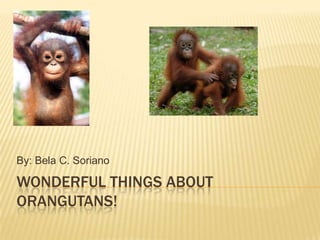
Bela animal research
- 1. Wonderful Things About Orangutans! By: Bela C. Soriano
- 2. Diet- What Do They Eat? Orangutans eat a fruit called Durian. Orangutans also eat Leaves, Mushrooms , Flowers , Insects and nuts but their favorite foods are fruit and leaves .Most of their water comes from the food that they eat. Siencetists have counted more than 400 different fruits and plants they eat.
- 3. Diet-How Do They Get Food? Orangutans get their food from some trees in the tropical forests where they live. Some other animals who live in tropical forests eat fruit like orangutans.
- 4. Life Cycle-Children and Babies! A baby orangutan is covered with red hair when it is born.The baby weighs about 4 pounds. At age 3 or 4 the young orangutan begins to take care of itself. It starts to move and find food. By age 5 it is trying to make its own nest . Childhood ends by age 7 or 8 years old. Baby orangutans drink milk from its mother. Mothers clean their babies by licking them.
- 5. Life Cycle-Teens and Adults! At age 7 to 10 years old they weigh to 44 pounds to 110 pounds . Childhood ends but the orangutan still stays with its mother . At 15 years old they weigh about 70 to 250 pounds . Male and Female orangutans are fully grown . An orangutans lifespan is about 35-40 years in the wild and sometimes into the 50’s in captivity.
- 6. Physical Features-Males vs. Females! Males often weigh over 200 pounds. The males live alone until they find a Female. Males grow to 4 to 5 feet long and they have thick long hair that can reach 20 inches. They have large cheek pads on their faces. Females are 1 the males size. Female orangutans grow to 3 ½ feet and they don’t have cheek pads they have voice pouches.
- 7. Physical features- Parts of the face! Male Orangutans usually have have beards. They have really good eyesight. Their jaw is so big it can carry large things in its mouths. Their back teeth is so strong it can crack rough and big things. The lips of an orangutan has a major roll in its life. Before they eat a piece of fruit they feel the fruit with its lips to see if it is good. Then they take it out of their mouth and start to munch it up!
- 8. Dangers and Threats- Endangered animal! Orangutans are an endangered animal. In Borneo, there are 10,000-15,000 orangutans. Their tropical forests are getting cut down so they have small places to live. In Sumatra, there are 9,200 orangutans left. Orangutans live in a lot of parts of Borneo and live in three parts of Sumatra. They live in the tropical forest near the ocean.
- 9. Physical features- Arms and legs! Orangutans use its arms to walk in the forest. When the orangutan put its arms down it can reach its ankles. The orangutans hands and feet are curved so it can swing and climb on trees. Orangutans have four fingers and one opposable thumb to grab stuff.
- 11. Physical Features-Similar body parts! Orangutans are similar to human beans. They have 32 teeth and they get cavities. The male orangutan grows a beard when it gets older like human men.
- 12. Daily life! In the orangutans daily life they swing from tree to tree. Their arms are 1 ½ times longer than its legs. Baby orangutans cant swing on the trees yet so their mom has to teach them. Every hour an orangutan is looking for food than doing anything else. In the nighttime orangutans make nests. When a child orangutan is about 7 or 8 years old it makes a nest right nest right next to its moms nest.
- 13. Daily Life! Orangutans swing from tree to tree with theirlongarms. Orangutans spend most of their life in trees. When night time comes the orangutans have to build a nest and sometimes they add roofs to make them stay dry if it rains. They also use leafy branches to shelter themselves from the rain and sun.
- 14. Appearance- Borneo and Sumatran! There are two types of orangutans. One kind is a Borneo orangutan. They have gray skin and red hair with really rough skin. The other kind is a Sumartan orangutan they are taller than Borneo orangutans. They have brighter red hair. Males grow beards to look like old men. Borneo orangutans have less hair and a square shaped face too. Sumartran orangutans have thin faces.
- 15. Habitat-Tropical forests! Orangutans live in tropical forests with other kinds of animals. Orangutans live in Sumatra and Borneo. They live in forests because they like to swing on trees.